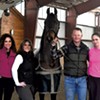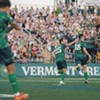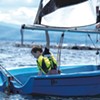Published January 22, 2017 at 5:30 a.m. | Updated January 22, 2017 at 8:42 a.m.
After classes end one Wednesday afternoon, a gaggle of students bolts across the playground at J.J. Flynn Elementary School and plunges into the woods, heading toward the Burlington Bike Path. Once a week for their after-school program, these fourth and fifth graders, accompanied by college-age mentors from the University of Vermont, walk a mile from their New North End school to Derway Island, a natural area near the mouth of the Winooski River.
The group is out bird-watching, but the kids make such a racket along the way — swinging sticks, yelling to friends, tossing around tennis balls — that's it's hard to imagine they'll see any wildlife at all.
Yet less than 10 minutes into their walk, the kids and their "co-explorers" — as their mentors from UVM's Rubenstein School of Environment and Natural Resources are called — suddenly shush each other, scan the woods with binoculars and point. A kid has spotted a large brown-and-white barred owl perched on a tree limb about 40 feet up, a sighting even experienced birders in the group say is impressive.
After a few minutes, the owl flies off and the kids resume their noisy trek, stopping next at a wooden railing along the bike path that overlooks Lake Champlain. There, Nathaniel Sharp, a UVM junior who's majoring in wildlife biology, points out other bird species to the kids, including his "birding buddy," Colby, a towheaded 9-year-old whose T-shirt reads, "I'm just here for the snacks."
"There's a white-breasted nuthatch up there," Sharp shouts. "And we've got some ducks over there and ... Oh, look! Snow buntings! See that flock?" The kids reply with a chorus of "oohs" and "aahs" as the birds sail by. Sharp, the group's unofficial ornithologist, says he's been birding since he was Colby's age. In 2013, he was on the first high school team to win New Jersey's annual World Series of Birding.
Notwithstanding Sharp's avian acumen, many of the wildlife sightings these co-explorers make are new to the grade-schoolers and college students alike. The two groups learn from each other, which is why UVM lecturer Trish O'Kane brought them together.
"A lot of these college students had never seen an owl, and a little boy just taught them that," she says. "Now, that's really cool!"
O'Kane is the creator and instructor of Birding to Change the World, an environmental justice course that gets children and their college mentors exploring the outdoors together. The mentors are her students.
First taught at UVM when O'Kane arrived a year ago — she previously taught the class at the University of Wisconsin-Madison — the service-learning course aims to reverse an alarming national trend: Children are spending remarkably less time in nature than did previous generations, resulting in physical and emotional deficiencies that child advocacy expert Richard Louv has dubbed "nature-deficit disorder." NDD isn't a clinically recognized mental diagnosis. But as Louv posits in his book Last Child in the Woods — a required text in O'Kane's course — children who lack regular exposure to nature are more prone to anxiety, depression, obesity and attention disorders, and they also exhibit limited respect for their natural surroundings.
Each semester, O'Kane handpicks 18 UVM students to take her capstone course. As she explains, she not only wants students with solid grades and relevant majors, but also those who are responsible enough to mentor a child and show up every week. Most are seniors in UVM's environmental sciences or environmental studies programs, though O'Kane has also accepted outdoor education, recreation and tourism majors.
Next, O'Kane pairs each college student with a fourth or fifth grader, all of whom are enrolled in Flynn's after-school program. There's no cost to the school kids' families beyond the normal after-school fees.
What criteria does she use to match mentor and mentee? O'Kane says she asks each to choose which animal they'd like to be. She then pairs them by animal species: big cats with big cats, raptors with raptors, reptiles with reptiles, and so on.
"I call it 'Birding to Change the World,' but the truth is, we go with whatever that kid's individual interest is," O'Kane explains. For example, some kids are crazy about frogs, others about snakes, still others about beavers, plants or bugs. From the get-go, O'Kane tells her UVM students, "Don't start by trying to 'teach' them anything. First, see what they care about and what they're interested in. Then, you can start teaching them."
Twelve years ago, O'Kane never would have imagined she'd be teaching a college-level course on birding — or anything else related to wildlife biology or the environment, for that matter. Back then, she hadn't taken a biology class since eighth grade.
O'Kane's educational background and professional career was more human- than animal-oriented. She grew up in Orange County, Calif., then attended the University of Southern California in the 1980s. While still an undergraduate at USC, O'Kane became a student activist working to end apartheid in South Africa and U.S. military interventions in Central America.
After graduating from USC in 1985, O'Kane moved to Nicaragua, where she worked for four years as a freelance investigative reporter, then spent another six in Guatemala working as a journalist and United Nations investigator researching human-rights abuses and war crimes.
After a decade in Central America, O'Kane earned her master's degree in development studies from the London School of Economics and Political Science. Next she returned to the United States for a position at the Southern Poverty Law Center, where she spent another five years working on civil-rights issues. It wasn't until she landed a job teaching journalism at Loyola University in New Orleans, in August 2005, that her study of the environment — and not just the people who live in it — became very real.
Twenty-eight days after she relocated to New Orleans, Hurricane Katrina left O'Kane's house submerged beneath 11 feet of water. O'Kane and her husband had evacuated to Alabama 36 hours earlier and didn't return to New Orleans for four months. It was only upon her return, as her newly adopted city was still reeling from the aftermath of one of the nation's worst environmental disasters, that O'Kane became keenly aware of the first signs of life returning to the city: the birds.
"That first morning back I woke to something strange and rare in New Orleans — silence. I lay in bed and listened. Then I heard clicking — cardinals — soon joined by an army of beeping bulldozers," O'Kane wrote in an August 16, 2014, op-ed piece in the New York Times. "I took a cup of coffee and sat on the back stoop. About a dozen small brown sparrows clung to a few spindly trees. Where did they go during the hurricane? How did they survive?"
O'Kane, who confesses that she had "zero interest" in birds before the storm, quickly became fascinated by their return to New Orleans. For her as well as her students, observing and studying avian life became a form of therapy. She'd often bring her students, many of whom were as shell-shocked as she was by the devastation, to nearby Audubon Park, where they'd watch the ducks and observe migratory birds re-inhabiting this toxic, lifeless place. As she wrote in the Times, "I realized, then, that the birds had become our teachers."
And they would continue teaching her for years to come. A decade later, O'Kane had earned her PhD in environment and resources, and had created Birding to Change the World, pairing University of Wisconsin students with school kids from inner-city Madison. She became an avid bird-watcher in Madison's 200-acre Warner Park, eventually identifying 141 bird species there.
O'Kane used the mentor/mentee structure, she says, because it had worked so well for her in a cub reporter program she'd previously developed at Auburn University. There, she'd paired aspiring high school journalists with college journalism majors and helped get their coauthored stories published in some of Alabama's most prestigious newspapers.
O'Kane likens the mentoring relationship to one between an older and younger sibling. Because they're so close in age, the children don't see the college students as authority figures so much as role models. "There's this thing where college kids are cool. And in middle and high school, and even in elementary school, it's all about the culture of cool," she says. "And, of course, we want education to be cool."
When the students finally arrive at Derway Island — an hour after departing Flynn — the bonds between younger and older co-explorers are on full display.
Melody Salerno, a senior in environmental studies from Brooklyn, N.Y., snaps some selfies with Molly, her fourth-grade co-explorer with whom she was paired because they're both "cats."
"She's the light of my week," Salerno says with a smile, just before Molly practically tackles her with a bear hug. As Molly darts off to chase some girls who are scrambling up a fallen tree limb some 10 feet above the trail, Salerno reflects on the kids' wilderness adventures — ones that Salerno herself never experienced growing up in Brooklyn.
"That's part of the beauty of this class, letting them climb that tree and do something that might be a little dangerous," she says. "It's up to them to decide their awareness with space and understand when going that high is too far."
Mariah Notini, a UVM senior from Lowell, Mass., had a similar experience with her mentee. As she follows a trio of girls racing through the woods, Notini says it's hard to believe these are the same kids she met at the beginning of the semester.
"The first few weeks, before the girls did anything even slightly risky, they'd look at me and say, 'Can we do this? Am I allowed to do this?'" Notini recalls. "That went for climbing a fence, climbing a tree, even just running ahead, literally anything outside of walking in a straight line."
Notini admits she had some initial trepidation of her own about taking this class, as she'd never worked with kids before and wasn't sure how tightly to hold the reins.
"At the beginning it was easy to be hard on myself for not knowing the answers to all their questions," she says. "I felt like I didn't know enough about nature and had to teach them about everything we saw." She's since realized that the reason she's there is more to "encourage curiosity rather than constantly have an answer."
But to that end, O'Kane also wants the kids to get their questions answered. So she asks the school kids to assign their college mentees weekly "research questions" about things they've encountered while walking in the woods — and even has the kids grade their mentees' "homework." Some questions are relatively straightforward, such as "Why do stinging nettles sting?" or "Why does poison ivy cause a rash?" Others are far less conventional.
"Our children like us to make really weird perfumes for them," notes Lily Myers, a junior in environmental studies from Calais. Once, she says, a research question required her to make one perfume that smelled like ice cream, another like cinnamon. What grade did the kids give her? "I think we passed," she says.
How effective is the class at achieving its ultimate goal of getting kids into the wild? Myers points out that, since they began bringing the Flynn students to Derway Island, some kids have started going there on their own time, as most live nearby. "They're starting to love this place," she adds, "which is really exciting."
Indeed, Graham Clarke, Flynn's principal, says that the reviews he's heard, from students and parents alike, are unanimous: "They all speak incredibly highly of it," he says. When we spoke, Clarke had just left a meeting with the parents of a boy in the program who's had a tough time fitting in at school. His parents described the program to Clarke as "three hours in the middle of the week that's the crown jewel of the boy's school experience." O'Kane hopes to expand the program to Lyman C. Hunt Middle School and Burlington High School so she can track these students' progress.
Colby, the 9-year-old who's partnered with Sharp, describes Birding to Change the World as "one of my favorite things to do."
"I'm speechless. I just saw an owl today," he says as the light fades from the sky. "What could be better?"
This article was originally published in Seven Days' monthly parenting magazine, Kids VT.
More By This Author
Speaking of...
-

UVM, Middlebury College Students Set Up Encampments to Protest War in Gaza
Apr 28, 2024 -

Page 32: Short Takes on Five Vermont Animal Books
Apr 24, 2024 -

Teen Tweets: Burlington Middle Schoolers Make Colorful Avian Collages
Mar 12, 2024 -

Imagine the World We Expect From Kids
Mar 12, 2024 -

Swedish Cinnamon Rolls: A Recipe for 'Kanelbullar'
Mar 12, 2024 - More »
Comments
Comments are closed.
From 2014-2020, Seven Days allowed readers to comment on all stories posted on our website. While we've appreciated the suggestions and insights, right now Seven Days is prioritizing our core mission — producing high-quality, responsible local journalism — over moderating online debates between readers.
To criticize, correct or praise our reporting, please send us a letter to the editor or send us a tip. We’ll check it out and report the results.
Online comments may return when we have better tech tools for managing them. Thanks for reading.




































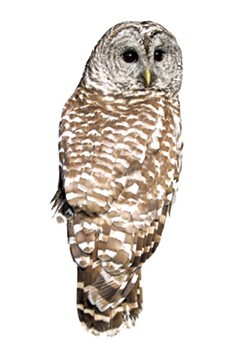
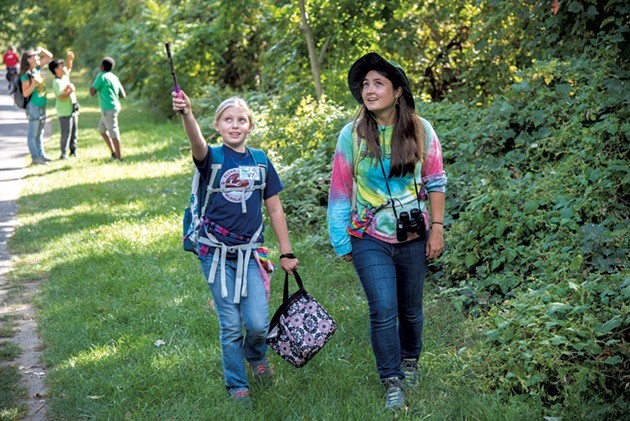
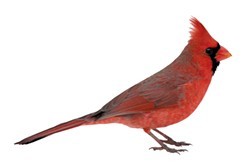

![National Mentoring Month [SIV474]](https://media1.sevendaysvt.com/sevendaysvt/imager/u/square/3946624/episode474.jpg)

